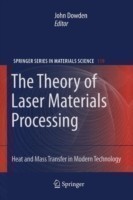Theuseoflasersinmaterialsprocessinghasbecomewidespreadinrecent years,sothatanunderstandingofthenatureofheatandmasstransferin thisbranchofmoderntechnologyisofincreasingimportance. Theaimofthe authorsofthisbookistoconcentrateonthephysicalprocesses;thesecanbe developedfromamathematicalpointofview,orfromdirectexperimental- derivedobservation. Thetwoapproachesarecomplementary;eachcanprovide insightsandthesynthesisofthetwocanleadtoaverypowerfulunderstanding oftheprocessesinvolved. Mathematicalmodellingofphysicalprocesseshas hadanimportantroletoplayinthedevelopmentoftechnologyoverthe centuriesandparticularlysointhelastonehundredand?ftyyearsorso. Itcanbearguedthatitismoreimportanttodaythaneverbeforesincethe availabilityofhigh-speedcomputersallowsaccuratenumericalsimulationof industrialprocessesatafractionofthecostofthecorrespondingexperiments. Thisisoneaspectofmathematicalmodelling,highpro?leandmuchvalued, butitisnottheonlyone. Inthepastmathematicalmodellinghadtorelyonqualitativeinves- gation,veryspecialanalyticalsolutions,orinaccurateandtime-consuming calculationsperformedwithlittleinthewayoftabulatedormechanical assistance.
Logtablesandsliderulesarestillrememberedbypeopleworking today,thoughtherearesurelyfewwhoregrettheirdisappearance. Thevalueanddistinctivefunctionofmethodsbasedontheanalytical approachisnowbecomingmuchclearer,nowthattheyarenolongerexpected toproducedetailedimitationsofwhathappensinrealexperimentsofind- trialprocesses,afunctionnowful?lledmostlybynumericalmethods,c- sideredbelow. Theemphasistodayisontheirabilitytocon?rmandextend ourunderstandingofthebasicphysicalmechanismsinvolvedintheprocesses of interest. These are essential for any intelligent use of numerical simulation. Theargumentaboutthevalueofteachingpeoplehowtodoarithmetic themselveswithouttheaidofacalculatorseemstobepassingintohistory, vi Preface butitisanimportantoneandprovidesasimpleanalogy. Ifsomeonedoes nothaveafeelingfornumbersandthewayarithmeticworks,theywillalltoo easilyfailtospotanerrorproducedbyamachine. Computersarenotinfallible -andneitherarethosewhobuildorprogramthem. Computersarenow takingonlessmundanemathematicaltasksandthesamecontroversiesare appearinginconnectionwithalgebraicmanipulation.
Equally,andwitheven greaterpenaltiesintermsofcostintheeventoferrors,thesameconsiderations applytonumericalsimulationofmajorindustrialprocesses. Awarenessofthe analyticalsolutionscanbeinvaluableindistinguishingtherightfromthe wrong,i. e. forthepractitionertounderstandthebasisofthework,andto haveanideaofthekindsofoutcomesthatareplausible-andtorecognise thosewhicharenot. Thephrase"mathematicalmodelling"is,however,ambiguous,perhaps morenowthanithaseverbeen. Thereisanenormousamountofworkdone todayonsimulationbasedontheuseofverypowerfulcomputerprograms, anditisquitecorrectlyreferredtoasmathematicalmodelling. Theprograms aresometimesconstructedin-housebutareusuallycommercialpackages. This isanentirelyvalidapproachwithspeci?c(generallycommercial)objectives. Ingeneraltherearetwouses. Thedominantobjectiveisnumericalagreement withaparticularexperimentinthe?rstinstance,leadingtopredictivec- mercialuseinthesecondinstance. Thesecondobjectiveistheclari?cation ofphysicalmechanisms,aimedatthegenerationofunderstandingofcomplex interconnectedprocesses,ratherthantheexactreproductionofaparticular experiment. Itissometimesoverlookedthat,withsu?cientcare,anum- icalapproachisequallyvalidintheinvestigationofphysicalfundamentals.
Numericalsimulationisnotacentraltopicofthisbook,butbecauseofits crucialimportancetoeachofthetwousestowhichnumericalmodellingcan beput,itisvitalthatthecomputationalbasisoftheworkshouldbec- pletelysound. Inaddition,thelevelofprocessdetailwhichcanbeconsidered bythenumericalapproachusuallyexceedswhatispossiblewiththeanaly- calapproachsigni?cantly,leavinglittlechoicebuttoreverttothenumerical treatmentwheninvestigatingtheinterconnectionsbetweenprocesses. Itis forthesereasonsthatthebookconcludeswithachapteroncomprehensive numericalsimulation. Inmanyways,theapproachadoptedhereiscomplementarytothemore phenomenologicalapproach. Itisalwaysimportantina?eldwhichhasvery directindustrialapplicationstobearinmindhowtechniquessuchasthose describedherewillbeused,butitisessentialnottolosesightofthef- damentals. Thereareserioussafetyimplications;therearecostimplications; therearemoralimplications;thereareconsiderationsoftheappropriateness ofthetechnologytotheapplicationunderconsideration. Aproperrespectfor alltheserequiresanunderstandingofthefundamentals. Wearealltoowellawarethatthisbookdoeslittlemorethanscratch thesurfaceoftheproblemsinvolvedinafundamentalunderstandingofthese phenomena.
Ifwehaveprovidedideasandinformationthatcauseothersto Preface vii testthemexperimentallyorintellectually,agreewiththemordisputethem vigorously,anddevelopthemfurther,wewillconsiderthatwehaveachieved ouraim. Colchester April,2008 JohnDowden Contents 1MathematicsinLaserProcessing JohnDowden...1 1. 1 MathematicsanditsApplication...1 1. 2 FormulationinTermsofPartialDi?erentialEquations...3 1. 2. 1 LengthScales...3 1. 2. 2 ConservationEquationsandtheirGeneralisations...4 1. 2. 3 GoverningEquationsofGeneralised ConservationType...7 1. 2. 4 Gauss'is,however,ambiguous,perhaps morenowthanithaseverbeen. Thereisanenormousamountofworkdone todayonsimulationbasedontheuseofverypowerfulcomputerprograms, anditisquitecorrectlyreferredtoasmathematicalmodelling. Theprograms aresometimesconstructedin-housebutareusuallycommercialpackages. This isanentirelyvalidapproachwithspeci?c(generallycommercial)objectives. Ingeneraltherearetwouses. Thedominantobjectiveisnumericalagreement withaparticularexperimentinthe?rstinstance,leadingtopredictivec- mercialuseinthesecondinstance. Thesecondobjectiveistheclari?cation ofphysicalmechanisms,aimedatthegenerationofunderstandingofcomplex interconnectedprocesses,ratherthantheexactreproductionofaparticular experiment.
Itissometimesoverlookedthat,withsu?cientcare,anum- icalapproachisequallyvalidintheinvestigationofphysicalfundamentals. Numericalsimulationisnotacentraltopicofthisbook,butbecauseofits crucialimportancetoeachofthetwousestowhichnumericalmodellingcan beput,itisvitalthatthecomputationalbasisoftheworkshouldbec- pletelysound. Inaddition,thelevelofprocessdetailwhichcanbeconsidered bythenumericalapproachusuallyexceedswhatispossiblewiththeanaly- calapproachsigni?cantly,leavinglittlechoicebuttoreverttothenumerical treatmentwheninvestigatingtheinterconnectionsbetweenprocesses. Itis forthesereasonsthatthebookconcludeswithachapteroncomprehensive numericalsimulation. Inmanyways,theapproachadoptedhereiscomplementarytothemore phenomenologicalapproach. Itisalwaysimportantina?eldwhichhasvery directindustrialapplicationstobearinmindhowtechniquessuchasthose describedherewillbeused,butitisessentialnottolosesightofthef- damentals. Thereareserioussafetyimplications;therearecostimplications; therearemoralimplications;thereareconsiderationsoftheappropriateness ofthetechnologytotheapplicationunderconsideration. Aproperrespectfor alltheserequiresanunderstandingofthefundamentals.
Wearealltoowellawarethatthisbookdoeslittlemorethanscratch thesurfaceoftheproblemsinvolvedinafundamentalunderstandingofthese phenomena. Ifwehaveprovidedideasandinformationthatcauseothersto Preface vii testthemexperimentallyorintellectually,agreewiththemordisputethem vigorously,anddevelopthemfurther,wewillconsiderthatwehaveachieved ouraim. Colchester April,2008 JohnDowden Contents 1MathematicsinLaserProcessing JohnDowden...1 1. 1 MathematicsanditsApplication...1 1. 2 FormulationinTermsofPartialDi?erentialEquations...3 1. 2. 1 LengthScales...3 1. 2. 2 ConservationEquationsandtheirGeneralisations...4 1. 2. 3 GoverningEquationsofGeneralised ConservationType...7 1. 2. 4 Gauss'Theuseoflasersinmaterialsprocessinghasbecomewidespreadinrecent years,sothatanunderstandingofthenatureofheatandmasstransferin thisbranchofmoderntechnologyisofincreasingimportance. Theaimofthe authorsofthisbookistoconcentrateonthephysicalprocesses;thesecanbe developedfromamathematicalpointofview,orfromdirectexperimental- derivedobservation. Thetwoapproachesarecomplementary;eachcanprovide insightsandthesynthesisofthetwocanleadtoaverypowerfulunderstanding oftheprocessesinvolved.
Mathematicalmodellingofphysicalprocesseshas hadanimportantroletoplayinthedevelopmentoftechnologyoverthe centuriesandparticularlysointhelastonehundredand?ftyyearsorso. Itcanbearguedthatitismoreimportanttodaythaneverbeforesincethe availabilityofhigh-speedcomputersallowsaccuratenumericalsimulationof industrialprocessesatafractionofthecostofthecorrespondingexperiments. Thisisoneaspectofmathematicalmodelling,highpro?leandmuchvalued, butitisnottheonlyone. Inthepastmathematicalmodellinghadtorelyonqualitativeinves- gation,veryspecialanalyticalsolutions,orinaccurateandtime-consuming calculationsperformedwithlittleinthewayoftabulatedormechanical assistance. Logtablesandsliderulesarestillrememberedbypeopleworking today,thoughtherearesurelyfewwhoregrettheirdisappearance. Thevalueanddistinctivefunctionofmethodsbasedontheanalytical approachisnowbecomingmuchclearer,nowthattheyarenolongerexpected toproducedetailedimitationsofwhathappensinrealexperimentsofind- trialprocesses,afunctionnowful?lledmostlybynumericalmethods,c- sideredbelow. Theemphasistodayisontheirabilitytocon?rmandextend ourunderstandingofthebasicphysicalmechanismsinvolvedintheprocesses of interest.
These are essential for any intelligent use of numerical simulation. Theargumentaboutthevalueofteachingpeoplehowtodoarithmetic themselveswithouttheaidofacalculatorseemstobepassingintohistory, vi Preface butitisanimportantoneandprovidesasimpleanalogy. Ifsomeonedoes nothaveafeelingfornumbersandthewayarithmeticworks,theywillalltoo easilyfailtospotanerrorproducedbyamachine. Computersarenotinfallible -andneitherarethosewhobuildorprogramthem. Computersarenow takingonlessmundanemathematicaltasksandthesamecontroversiesare appearinginconnectionwithalgebraicmanipulation. Equally,andwitheven greaterpenaltiesintermsofcostintheeventoferrors,thesameconsiderations applytonumericalsimulationofmajorindustrialprocesses. Awarenessofthe analyticalsolutionscanbeinvaluableindistinguishingtherightfromthe wrong,i. e. forthepractitionertounderstandthebasisofthework,andto haveanideaofthekindsofoutcomesthatareplausible-andtorecognise thosewhicharenot. Thephrase"mathematicalmodelling"is,however,ambiguous,perhaps morenowthanithaseverbeen. Thereisanenormousamountofworkdone todayonsimulationbasedontheuseofverypowerfulcomputerprograms, anditisquitecorrectlyreferredtoasmathematicalmodelling.
Theprograms aresometimesconstructedin-housebutareusuallycommercialpackages. This isanentirelyvalidapproachwithspeci?c(generallycommercial)objectives. Ingeneraltherearetwouses. Thedominantobjectiveisnumericalagreement withaparticularexperimentinthe?rstinstance,leadingtopredictivec- mercialuseinthesecondinstance. Thesecondobjectiveistheclari?cation ofphysicalmechanisms,aimedatthegenerationofunderstandingofcomplex interconnectedprocesses,ratherthantheexactreproductionofaparticular experiment. Itissometimesoverlookedthat,withsu?cientcare,anum- icalapproachisequallyvalidintheinvestigationofphysicalfundamentals. Numericalsimulationisnotacentraltopicofthisbook,butbecauseofits crucialimportancetoeachofthetwousestowhichnumericalmodellingcan beput,itisvitalthatthecomputationalbasisoftheworkshouldbec- pletelysound. Inaddition,thelevelofprocessdetailwhichcanbeconsidered bythenumericalapproachusuallyexceedswhatispossiblewiththeanaly- calapproachsigni?cantly,leavinglittlechoicebuttoreverttothenumerical treatmentwheninvestigatingtheinterconnectionsbetweenprocesses. Itis forthesereasonsthatthebookconcludeswithachapteroncomprehensive numericalsimulation.
Inmanyways,theapproachadoptedhereiscomplementarytothemore phenomenologicalapproach. Itisalwaysimportantina?eldwhichhasvery directindustrialapplicationstobearinmindhowtechniquessuchasthose describedherewillbeused,butitisessentialnottolosesightofthef- damentals. Thereareserioussafetyimplications;therearecostimplications; therearemoralimplications;thereareconsiderationsoftheappropriateness ofthetechnologytotheapplicationunderconsideration. Aproperrespectfor alltheserequiresanunderstandingofthefundamentals. Wearealltoowellawarethatthisbookdoeslittlemorethanscratch thesurfaceoftheproblemsinvolvedinafundamentalunderstandingofthese phenomena. Ifwehaveprovidedideasandinformationthatcauseothersto Preface vii testthemexperimentallyorintellectually,agreewiththemordisputethem vigorously,anddevelopthemfurther,wewillconsiderthatwehaveachieved ouraim. Colchester April,2008 JohnDowden Contents 1MathematicsinLaserProcessing JohnDowden...1 1. 1 MathematicsanditsApplication...1 1. 2 FormulationinTermsofPartialDi?erentialEquations...3 1. 2. 1 LengthScales...3 1. 2. 2 ConservationEquationsandtheirGeneralisations...4 1. 2. 3 GoverningEquationsofGeneralised ConservationType...7 1. 2. 4 Gauss'sLaw...10 1.
3 BoundaryandInterfaceConditions...11 1. 3. 1 GeneralisedConservationConditions...11 1. 3. 2 TheKinematicConditioninFluidDynamics...13 1. 4 Fick'sLaws...15 1. 5 Electromagnetism...15 1. 5. 1 Maxwell'sEquations...15 1. 5. 2 Ohm'sLaw...18 References...19 2SimulationofLaserCutting WolfgangSchulz,MarkusNiessen,UrsEppelt,KerstinKowalick...21 2. 1 Introduction...22 2. 1. 1 PhysicalPhenomenaandExperimentalObservation...23 2. 2 MathematicalFormulationandAnalysis...26 2. 2. 1 TheOne-PhaseProblem...29 2. 2. 2 TheTwo-PhaseProblem...42 2. 2. 3 Three-PhaseProblem...51 2. 3 Outlook...64 2. 4 Acknowledgements...65 References...65 x Contents 3KeyholeWelding:TheSolidandLiquidPhases AlexanderKaplan...71 3. 1 HeatGenerationandHeatTransfer...71 3. 1. 1 Absorption...



















